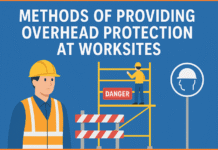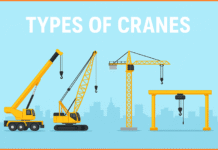Types of Guards and Selection:
Various types of machine guards available for machine guarding. their suitability should be selected. Most usable machine guards are described below.
Contents
Types of machine guard
- Fixed guards
- Fixed limited access guards
- Fixed adjustable access guard
- Interlock guards
- Semi automatic guards
- Automatic guards
Fixed guards
They are simple, easy to provide and cover parts as well as throwing particles if any. They are of various types of materials and design. A minimum thickness of 1.2 mm is recommended for sheet metal. Guard opening and its distance from the dangerous part should be fully safe. Such spacing and distance are prescribed and formulae are also available but it is rather a matter of fact of individual requirement. They should be a close fit, adjust and should withstand speed, vibration, impact, etc. They should be properly fitted by clamps, bolts, etc. They require special tools for their removal.

Every fixed guard (or other guards) on point of operation should prevent entry of fingers (preferably the smallest finger) or hands by reaching over, under or around the guard into the point of operation. Its fasteners should not be easily openable to prevent misuse or accident. On point of operation, it should offer full visibility while on transmission parts it may not.
Following formula was suggested by the Chief Inspector of Factories, the UK in his Report of 1975.

Fixed total enclosures are used to cover prime mover and transmission parts such as headstock gearing, belts, pulleys, etc.
Fixed limited access guards
Fixed limited access guards provide a minimum opening in the guard to insert and remove the job (material). It disallows finger to trap. If the material is jammed it requires a special tool and opening and refitting of the guard. They are used on power presses.
Fixed adjustable access guard
Fixed adjustable access guards provide an opening through or around the guard to accommodate materials of different sizes. Guards on band saws, jigsaw, milling cutter, etc. can be raised or lowered as per the thickness to cut. Such guard known as “crown guard” on a circular saw or drill tool adjusts automatically as the job or tool moves. Its disadvantage is that it gives little protection when thin material is processed.
Fencing distance or barrier guards make it physically difficult for people to gain access. Nip guard to in-running rolls and fixed railing or fencing to engines, motors, planning or shaping machine are of this type.
Interlock guards
Interlock guards make certain that the machine cannot be started until the guard screen is in the closed position and conversely the guard cannot be removed until the working parts have been stopped. Mechanical, electrical, hydraulic or pneumatic systems are used to actuate the guard. The mechanical interlocking of a power press, card machine and electrical (limit or microswitches) interlocking of headstock covers of many textile machineries are such examples. Many times the interlocking is by-passed or made ineffective which is not good. This is its disadvantage. The correct working condition of the limit switch is most important. Limit or microswitches are used but they are not fully safe.
Trip guards are actuated by anyone approaching beyond the safe position and operate a stop or reverse control viz. trip rod along the conveyor belt, hand trip on a rubber mill, electronic eye, lift, door, platen printing guard, calendars or dough brakes, etc.
Control guards activate the machine when the guard is closed and opening the guard stops it. Thus the guard acts as the on-off switch. Such guard is useful for the machine which can be brought to rest very rapidly. e.g. power press.
Automatic guards

Automatic guards will ensure that the operator is prevented from coming into contact with dangerous parts when the machine is set in motion accidentally. This guard is itself actuated by the movement of the dangerous part. It can only be used where sufficient time is available to remove the body part from the danger zone viz. sweep, knock or punch away guard on a power press or platen printing machine. Because of its stroke hazard, it is hardly used. Photo-electric guard (device) operates to stop the dangerous part when the light curtain is interrupted. This type of guard is used on shearing or cutting machine.
Safety by Machine Controls
These should be differentiated from incidental safety devices which are internal and work as a guard for protection. But the machine itself has many controls as its inherent or attached elements. All levels, buttons, brakes, pedals, switches, handles, wheels, auto controls, etc. are machine controls to run the machine safely and efficiently. Such controls should be clearly identified, marked and suitably placed for ease of operation. Their purpose and direction of movement shall be marked. Each stop button should accompany the start button and they should be sunk to prevent accidental pressing.
Levers should be capable of being locked in position. Levers, handles, or wheels should operate to give naturally anticipated direction (e.g. clockwise close and anticlockwise open, up forward, down reverse, etc.), control should be of fail-safe type i.e the machine will stop if the control fails. When there are more controls nearly placed or on one board clear instruction of their use must be marked to prevent their false operation. Locks or keys on some controls are required to prevent their undesired operation by mistake.
Safety by Precautions and Maintenance
Above paras highlight the need for utmost precautions in safe operation and maintenance of all safety guards, devices and controls. A man has made them and a man can make them ineffective or misuse. Therefore all precautionary operating measures are necessary for operators should be made aware of hazards in their works, location, and operation of machine controls, regular checking of guards, warning not to make the guards ineffective, repairs, adjustment, etc. by specially trained person, need of wearing tight-fitting clothing and protective equipment necessary and using right tools and equipment.
Criteria for Machine Guard Selection
Selection of a machine guard depends on the following factors:
- Its physical dimensions, weight, etc.
- Method of drive and power requirement.
- Limitations of speed, pressure, temperature, etc.
- Materials being processed or handled.
- Access requirements especially for setting, adjustment, and maintenance.
- Environmental factors such as noise, vibration, dust, fumes.
- Operation requirements such as visibility.
Built-in Safety Devices
The object of a built-in safety device is to design and make the machine, equipment, method, and environment so safe that the worker’s exposure to accident or injury is eliminated or controlled automatically.
It is well experienced that many times the guards provided on the machines are removed not refitted and dangerous parts run without guards. Such unsafe practice leads to accidents. Therefore it is always essential to incorporate built-in safety devices (guards) from the design stage so that they become an integral part of the machine and subsequent guarding is least required.
Built-in safety can be designed for point of operation, transmission parts, controls, maintenance adjustment, and cleaning. Unnecessary projecting parts should be avoided. Risk at the cutter, tool or equipment should be eliminated or minimized by design, enclosure, handle, etc., closed tools are safer than open tools, controls should be in easy reach and inching or slow motion, braking, tripping, reversing, etc. Should be provided where necessary.
Benefits of Built-in Safety Devices:
- They are safer from an accidental prevention point of view.
- They serve more than one purpose.
- They are less costly in the long run. Subsequent addition of guards requires frequent maintenance and they are usually more costly and less effective.
- They provide a better standard to the design and operation of the machine.
- Need for training and supervision to control unsafe acts is reduced.
- It helps for efficient production, high morale and less labor turnover.
For best results, planning at the initial engineering level is necessary. Right from the drawing and design stage to the delivery stage, all safety aspects should be built-in. The responsibility should also be extended to product design, machine design, plant layout and working conditions, selection and specification of materials, production planning, time study methods, the duty of production foreman and the duties of the workers.
The disadvantage of built-in guards is that slight modification or unanticipated circumstances, after machine installation can render the guarding less effective. Therefore necessary correction in safety device should be made if such change is required.
Also read this – PRINCIPLES OF MACHINE GUARDING
Also read this – REQUISITE CHARACTERISTICS OF MACHINE GUARD





Thanks. I got a good information on Machine Guarding.
Very informative information.Thank you.
If I own a factory that runs with many types of machinery, of course, I would look into the utmost safety of my workers. Now I understand that upgrades are done to improve the safe working system of equipment as well as lessen the safety supervision. But the main advantage I think is that accidents are avoided. I hope all businesses look into services that can ensure they have good safety upgrades.
Thanks good information,
can you share incidents of chemical industry with rootcause and corrective action data